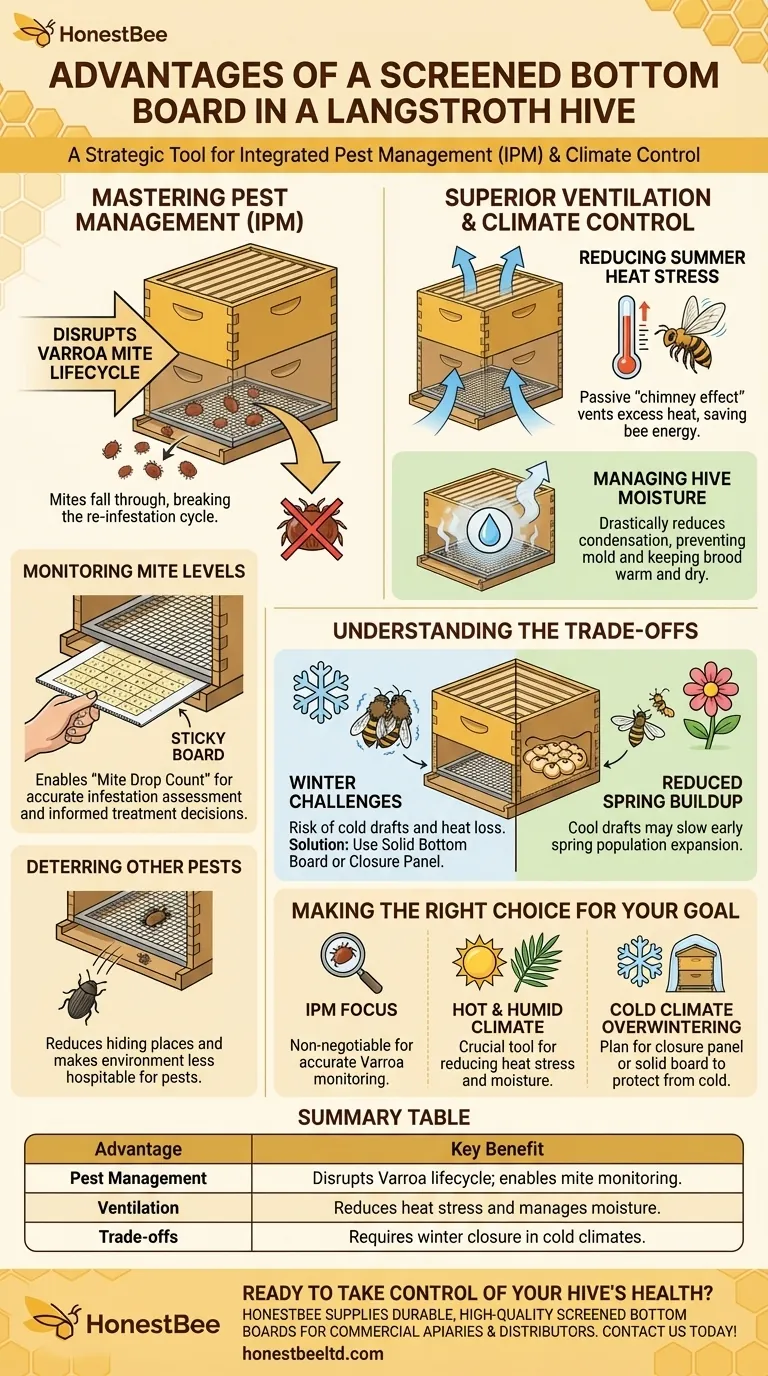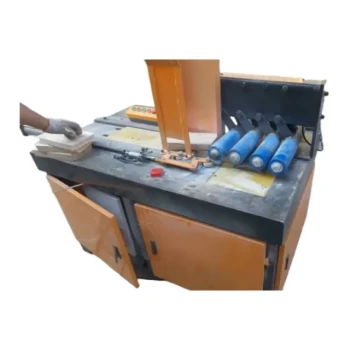The primary advantages of using a screened bottom board in a Langstroth hive are superior ventilation for climate control and a significant edge in managing pests, most notably Varroa mites. This design transforms the hive floor from a simple, static component into an active tool for monitoring and improving colony health.
A screened bottom board is not merely a ventilated floor; it is a strategic tool for Integrated Pest Management (IPM) and hive climate control. Its true value lies in empowering the beekeeper to actively monitor mite populations and manage in-hive humidity, shifting from passive observation to active management.

A Critical Tool for Pest Management
The most significant advantage of a screened bottom board is its role in a modern pest management strategy. It physically disrupts the lifecycle of the hive's most dangerous parasite.
Disrupting the Varroa Mite Lifecycle
Varroa mites periodically fall off their honey bee hosts. On a solid bottom board, these mites can survive and simply climb back onto a passing bee to re-infest the colony.
A screened bottom board breaks this cycle. When a mite falls, it passes through the mesh and out of the hive, permanently removing it from the population. This provides constant, passive pest control.
Monitoring Mite Levels
The screen enables the use of a "sticky board"—a corrugated plastic sheet coated with oil or grease—placed a few inches below the screen. Mites that fall through the mesh are trapped on the board for counting.
This practice, known as a "mite drop count," is the cornerstone of Integrated Pest Management (IPM). It allows you to accurately assess the level of infestation in your hive without intrusive inspections, enabling you to make informed decisions about when and if treatment is necessary.
Deterring Other Pests
The screen also reduces available hiding places for pests like Small Hive Beetles (SHB). While not a complete solution, it makes the hive environment less hospitable for them and can cause beetle larvae to fall out of the hive before they can pupate in the soil below.
Mastering Hive Ventilation and Climate
Proper airflow is critical for a colony's efficiency and health. A screened bottom board provides a significant, natural advantage in managing the hive's internal environment.
Reducing Summer Heat Stress
On hot days, a colony must expend significant energy and water resources to cool the hive through fanning and evaporation. This diverts workers from valuable foraging activities.
A screened bottom board provides a constant, upward flow of cool air, creating a "chimney effect" that passively vents excess heat and reduces the cooling burden on the bees.
Managing Hive Moisture
Excess moisture is a major threat, leading to moldy comb and creating a damp, stressful environment that can chill the brood. This is especially problematic in humid climates.
The excellent airflow from a screened bottom board drastically reduces condensation buildup, keeping the interior of the hive drier and healthier, particularly during the active months.
Understanding the Trade-offs
While highly beneficial, a screened bottom board is not a universal solution and presents challenges that require active management.
The Challenge of Wintering
The same airflow that is beneficial in summer becomes a dangerous liability in winter. A constant draft of cold air can rob the winter cluster of precious heat, forcing the bees to consume more honey stores and increasing the risk of starvation or freezing.
For this reason, most beekeepers in climates with cold winters either swap to a solid bottom board or insert a closure panel (sometimes called a Varroa tray) to seal the screen during the cold months.
Reduced Brood Rearing in Spring
In early spring, the colony needs to maintain a warm, stable temperature in the brood nest to rapidly expand its population. A screened bottom board can introduce cool drafts that slow this critical spring buildup compared to a solid board that better retains heat.
Making the Right Choice for Your Goal
The decision to use a screened bottom board depends on your specific climate and beekeeping philosophy.
- If your primary focus is Integrated Pest Management (IPM): A screened bottom board is non-negotiable for accurately monitoring Varroa mite levels before you treat.
- If your primary focus is managing bees in a hot, humid climate: The superior ventilation of a screened board is a crucial tool for reducing colony heat stress and moisture.
- If your primary focus is overwintering in a cold climate: Plan to use a solid board or ensure your screened board has a closure panel to protect your colony from life-threatening cold drafts.
Ultimately, viewing the bottom board not as a static floor but as an adjustable environmental control gives you greater command over the health and productivity of your hives.
Summary Table:
| Advantage | Key Benefit |
|---|---|
| Pest Management | Disrupts Varroa mite lifecycle; enables mite drop monitoring for IPM. |
| Ventilation | Reduces summer heat stress and manages excess hive moisture. |
| Trade-offs | Requires winter closure in cold climates to prevent heat loss. |
Ready to take control of your hive's health? HONESTBEE supplies durable, high-quality screened bottom boards and other essential beekeeping equipment to commercial apiaries and distributors. Our wholesale-focused operations ensure you get the reliable tools you need for effective Integrated Pest Management and superior colony performance. Contact HONESTBEE today to discuss your needs and enhance your beekeeping operation!
Visual Guide

Related Products
- Langstroth Screen Bottom Board for Beekeeping Wholesale
- Australian Pine Wood Langstroth Screen Bottom Board for Wholesale
- HONESTBEE Wooden Bee Escape Board with Triangle Mesh Design for Beekeeping
- Solid Bottom Board Australian Pine Wood Langstroth Bottom Board for Wholesale
- Black Plastic Beetle Barn Hive Beetle Trap for Beehives
People Also Ask
- What are the benefits of a screened bottom board? Boost Hive Health & Control Varroa Mites
- How does a screened bottom board assist with temperature control and pest management? A Key Tool for Modern Beekeeping
- What are the benefits of using a screened bottom board for beehives? Improve Ventilation & Mite Control
- What is the primary function of a screened bottom board in a hive? Enhance Ventilation & Control Varroa Mites
- How should the screened bottom board be used throughout the year? A Guide for Healthy Hives



















